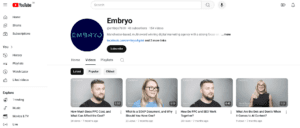
Video Length Stats: How Long Should Your Video Be?

In today’s digital world, marketing companies use video as a key aspect of advertising with 91% suggesting they use it as their most important marketing tool. Given this video lengths are not static and lots of variables contribute to this such as Target Audience, platform, Topic and more.
Video is more important than ever before and it’s a trend that’s not going away anytime soon. To make the most out of this marketing tool you will need to know which video length is best for you, your topic, goals and your target audience.
At Embryo, we take video marketing very seriously and it forms an important part of our digital marketing strategy. To learn more about that strategy feel free to get in touch with our team!
Quick Stats
- 87% of marketers feel that video has a direct, positive impact on sales
- 92% of video marketers reported that video gives them a positive ROI
- 96% of marketers agree that videos have helped increase user understanding of their product or service
- 70% of the marketers who don’t currently use video as a marketing tool, told us they plan to start in 2023
- Online video watched per week, per person, has almost doubled since 2018 but took a dip in 2023
- YouTube is the most widely used platform for hosting video with an average of 500 hours uploaded every minute
The Length of a Social Media Video
(Source: GoDaddy)
All social media platforms have a different target audience and attributed to this is a different attention span, these statistics then both lead to very different video lengths, and due to this there isn’t a “One fixes all” scenario.
For instance, TikTok can be considered the social media platform with the shortest videos, with the shortest allowed being 3 seconds, whereas Youtube can be considered one of the longest with no restriction on video length or topic allowing for videos which can be monetized starting at 8 minutes.
TikTok
TikTok, as mentioned previously, allows videos from 3 seconds up to 10 minutes, giving the opportunity to the creator on how long they want their videos to be. Given this, most TikTok videos stick to between 10-60 seconds long as the platform was created originally for quick short digestible content, this content is normally meme or trend-related.
Long-form content on the platform is rare accounting for only a small fraction of the daily uploaded content. This content is normally based around explainer videos or tutorials, video topics where detail is needed and so the longer format allows for this expansion.
The TikTok platform also includes live-streaming. On TikTok you can stream up to 4 hours of content before having to stop your livestream and start again, this is to prevent repetitive content and put focus on the short digestible content. TikTok suggests each live stream to last 30 minutes so that best practices are followed and the content stays relevant and interesting to your audience.
X/ Twitter
X (formally known as Twitter) has a similar audience to that of TikTok with them looking for short digestible content, for this reason, X restricts users to Video Tweets and Ads to be no longer than 2 minutes and 20 seconds, with between 30-45 seconds more likely to be featured by Twitter and having the highest engagement rates in-feed.
Pinterest is an “Explore/Discovery Platform”, coming with this, videos have no restrictions to allow the creators to express their topic how they like. This being said Pinterest suggests videos between 15-30 seconds to allow the content to be quickly digestible, with this they also suggest including a short visual message that can be pinnable as a thumbnail.
Instagram itself is a platform for visual content making it the perfect platform for video marketing. It has several formats for showing video including Story, In-feed, Reels, Ads and Live-streaming.
For In-feed videos, Instagram suggests between 15-30 seconds. This allows for quick viewing as the majority of the audience of Instagram is travelling.
For Reels video, Instagram has a new feature called Reels, this format is taken directly from TikTok and was developed to compete for the same audience. For this format, Instagram restricts its creators to 90-second videos in portrait, but you may not want to use the maximum to improve visibility and viewer engagement.
For Story video length Instagram restricts its creators to 15 seconds maximum, this then disappears after 24 hours.
There isn’t any restriction for Live-streaming on Instagram, with the only restriction coming from viewer engagement. Instagram for this format suggests livestreams between 10 minutes and 4 hours.
Updates are always coming to Instagram so it’s always best to stay up-to-date.
Videos on Facebook have been a long-standing feature and was the first platform to include video as an option. For In-feed videos, Facebook suggests between 24-90 seconds for the best viewer engagement while also having a restriction of 4 hours per video.
For Facebook ads, the platform suggests putting the majority of information within the first 5-10 seconds of a video to keep viewers engaged.
Facebook also owns the likes of Instagram so similar features of the platform have made their way to Facebook as well, such as Stories and Live-streaming. For the lengths of these Facebook suggests the same across all of its platforms.
With LinkedIn being the only B2B platform within these platforms the target audience found can be very different. Given this video length can also vary. It’s recommended that videos run between 30 seconds and 5 minutes, with a maximum set at 10 minutes to avoid losing viewer engagement.
Three-quarters of business executives, almost all of whom are on LinkedIn, say they watch online videos every week.
When it comes to Advertising on LinkedIn it’s in the best interest to catch the viewer’s attention quickly, due to this a shorter form of content is suggested with video length on average sticking between 15-30 seconds.
YouTube

YouTube is a known video streaming platform and has been since launching in February 2005. This veteran of video has multiple formats of video across its site to align itself better with different target audiences, these formats are In-feed, Shorts and Live-streaming.
In-feed video is the most common type of video on the site and boasts an astounding 500 hours of video uploaded every minute. In-feed video has a maximum length of 12 hours with most of these longer format videos being music marathons. The average length for this format can be between 8 minutes and 1 hour with 8 minutes of videos being the minimum that you can monetise and receive income from by having ads before and after your video.
“Shorts” are a relatively new feature that YouTube has embraced, this was to combat TikTok and Instagram Reels at their own game. For a “Short” YouTube suggests between 15-45 seconds with a maximum length of 60 seconds. This format is also vertical whereas the other formats on YouTube are landscape.
Creating Videos for Digital Channels

Digital channels can all be seen as separate and have no correlation to video length specifically. It’s based entirely on the topic of the channel, the use case, the product or the format. One rule to always follow is if it’s generating leads then it’s best to keep to a short format of under 1 minute as viewer engagement at this point of the user journey is very important.
Website
Videos on a website depend entirely on their placement, with a homepage video treated completely differently from that used on a product or any other internal page.
The best format for homepage videos is to treat them as a new lead, in doing this the video must be kept short (under 60 seconds) and include enough detail to encourage the viewer to carry on the user journey to the product or other internal pages to complete the lead.
Videos used on product or internal pages are not as restrictive as homepage videos as these videos are there to explain a product or feature/ service and the viewer at this point is on a fact-finding mission. Keeping videos under 5 minutes at this stage is also key as creating videos too long will normally overload the viewer causing them to stop their user journey. Only give the viewer the minimal amount of information they need, anything more detracts from the user experience.
Landing Page
Landing page videos can be treated very similarly to that of homepage videos where the viewer is normally a new lead so giving them straightforward facts within a short period of time helps the lead generation process. We suggest keeping videos between 30-60 seconds.
Studies show that:
- ⅕ of viewers bounce within the first 10 seconds after landing on a page
- ⅓ of viewers bounce within the first 30 seconds
- Including a video within the first 2 folds of a landing page can increase conversion by up to 80% if kept within the parameters set out above
Email marketing using video is a learning experience and depends entirely on your target audience. In most cases, it’s suggested to keep the video below 45 seconds to keep your audience engaged. It’s also worth embedding your videos and using a different platform such as YouTube to host them, this keeps the email smaller and includes fewer or zero external files to be downloaded.
A Quick Round-Up
As can be seen above all platforms have their own suggestions and restrictions on video publishing with the majority relating to two key factors, these being target audience and viewer engagement.
Understanding your audience is key when it comes to using video across websites and social media. If this is something important to you and your company Embryo takes video marketing very seriously and it forms a key part of our digital marketing strategy. To learn more about that strategy feel free to get in touch!



